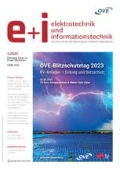Zusammenfassung
Die Energiewende in Europa stellt einen Evolutionsprozess in Richtung nachhaltige Energieversorgung dar. Die Motivation kommt durch den Klimawandel, die starke Importabhängigkeit von fossilen Energien, den Ausstieg aus der Kernenergie und die Marktreife der regenerativen Erzeugungstechnologien. Die regenerativen Erzeugungstechnologien erfordern die Installation größerer Leistungen bei niedrigeren Volllaststunden und erfordern daher einen Netzausbau. Die zukünftigen Strategien bei der Netzintegration sollten die Charakteristiken der Quellen stärker an die Eigenschaften der Netze anpassen durch Reduzierung der Leistung und Erhöhung der Volllaststunden. Die dezentralen Energiesysteme sind zukünftig notwendig, um durch Vorbilanzierung der Energieregionen den Bedarf an Übertragungskapazitäten auf wirtschaftlich und technisch realisierbare Werte zu reduzieren.
Abstract
The energy turnaround in Europe represents an evolution process in direction of renewable energy supply. The motivation is coming from climate change, strong import dependence on fossil energy, shut down scenarios of nuclear power plants and the market maturity of renewable generation technologies. The renewable energy technology necessitates the installation of higher generation power at lower capacity factors and thus needs grid development. The future strategies for the grid integration should result in changing the characteristics of renewable sources in direction of the nature of the grid by reduction of the installed power and simultaneously increasing the capacity factors. The development of decentralized energy systems is in future necessary, to allow a partial balancing between local generation and demand to limit the demand of grid extension according to economic and technological criteria.


Literatur
UNFCCC (1998): Kyoto protocol to the United Nations framework convention on climate change.
EU-Commission (2000): Green paper—towards a European strategy for the security of energy supply. EU-Commission.
Dreizehntes Gesetz zur Änderung des Atomgesetzes (13. AtGÄndG) vom 31.07.2011, Artikel 1: Änderung des Atomgesetzes (mit Festlegung der Restlaufzeiten der deutschen Kernkraftwerke).
Fraunhofer IWES (2014): Geschäftsmodell der Energiewende.
VDE (2012): Erneuerbare Energie braucht flexible Kraftwerke – Szenarien bis 2020. VDE-Studie 2012.
COM 85/3 (2008): Package of the implementation measures for the EU‘s objectives on climate change and renewable energy for 2020.
COM 15 (2014): A policy framework for climate and energy: in the period from 2020 to 2030.
EUREL (2012): Electrical power vision 2040 for Europe. Brussels, 05.06.2012.
Beurskens, L. W. M., Hekkenberg, M. (2011): Renewable energy projections as published in the national renewable energy action plans of the European member states. Copenhagen: European Environment Agency.
Author information
Authors and Affiliations
Corresponding author
Rights and permissions
About this article
Cite this article
Brauner, G. Die Energiewende in Europa: Technologische Herausforderungen an eine interdisziplinäre Energiestrategie. Elektrotech. Inftech. 132, 180–184 (2015). https://doi.org/10.1007/s00502-015-0294-5
Received:
Accepted:
Published:
Issue Date:
DOI: https://doi.org/10.1007/s00502-015-0294-5

